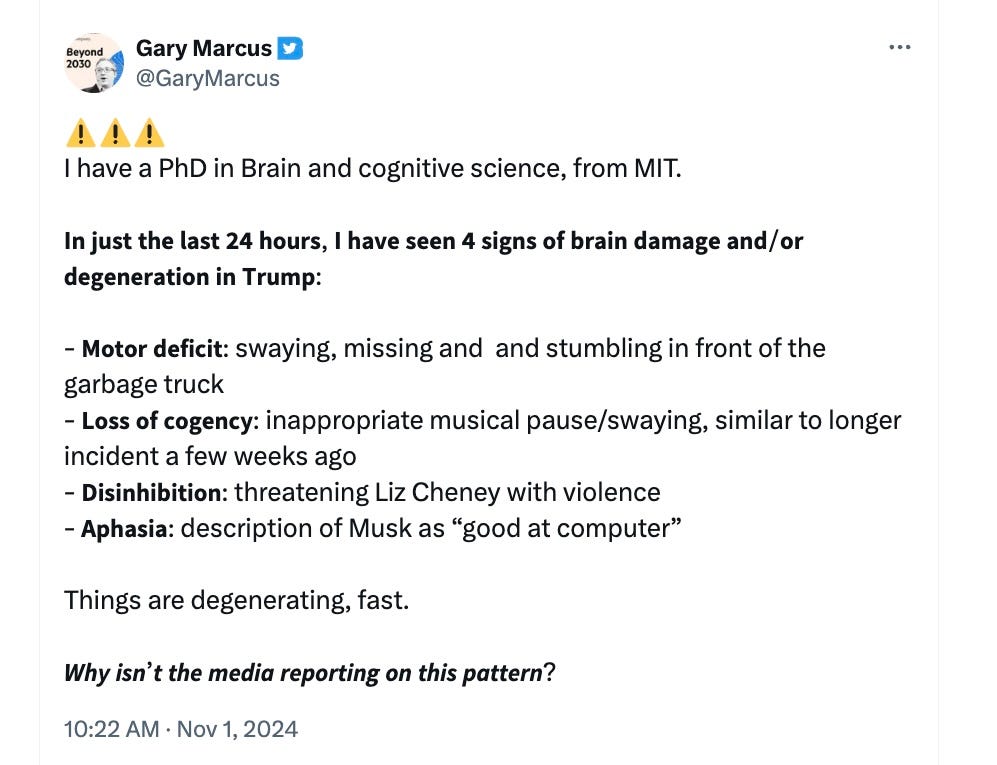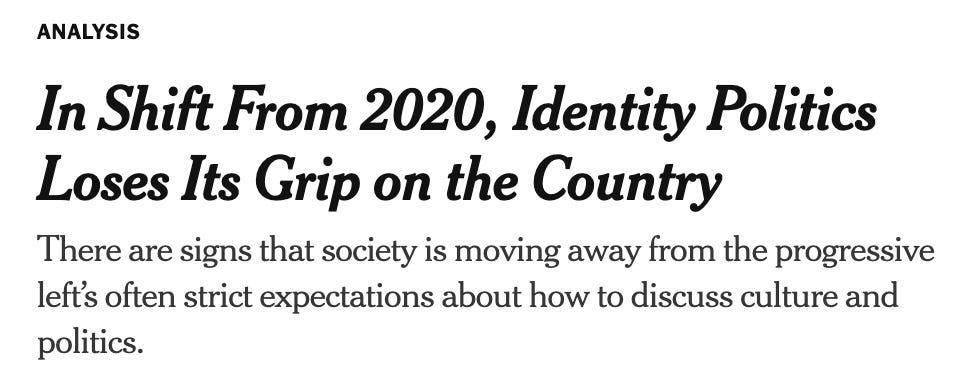Election Countdown, One More Day and a Wake-Up: Now It's Up to Us.
One thing we don't know, many things we do know. And some models for a better stage of American history that could be ahead.
Ninety-nine years ago, in October, 1925, Eleanor Roosevelt demonstrated how a voting machine worked, at the Women’s Arts and Industries Exhibit at the Hotel Commodore in New York. At the time, American women had been able to cast votes in only two presidential elections, 1920 and 1924. This year they may be the decisive bloc in the election. (Bettmann/ Getty Images.)
On the first day of this year, I started this “Election Countdown” series. It followed a 152-item series called the “Trump Time Capsules” that I wrote during the 2016 campaign.
The headline on that first item this year was, “Three hundred and nine days that will change the world.” The rationale was this:
The years after 2024 will depend on what happens to us in these upcoming days, and on what we do in response.
Recording what it is like for us to live through this period—when so much of the nation’s future depends on each of us, but when none of us can know the outcome—is the aspirational theme for this upcoming series. A journal of the plague year, when we can’t yet assess the disease’s final toll. Periodic markers and measures of what people learned and said, of how they responded, of who did what in a time of maximum trial.
I have in mind a range of standing features on how institutions and individuals are meeting this moment’s challenge. Naturally this will include the press, which is the institution I know best and the one that, in theory, can still make real-time corrections…
Let us hope, as I put it seven years ago [in writing a “Trump Time Capsule” series about the 2016 race], that people will look back on these 300-plus days with chastened wonder, and with cautionary guidance about our steps ahead.
Now we have just a day and a half until Election Day. Tens of millions of Americans have already cast their votes. If you’re one of those who wait, as Deb and I usually do, for the ritual of casting your vote in person, be sure to be there on Tuesday!
Here is a very quick survey of where we stand now. I’ll start with the main thing we don’t know. And then move to the important things we certainly know, and then to a surprising model for the future.
The one thing we don’t know:
What is going to happen two days from now, and between then and next January 20, and beyond.
It’s possible that right now votes could be “breaking” in a way that turns a very close race into a decisive result. Extreme example: the Carter-Reagan race in 1980 was considered too close to call until the very last days. When the votes were counted, they broke strongly in Reagan’s favor. He carried 44 states. No one is imagining that this time. But polls can be wrong.
It’s also possible that this year things will remain as close as the polls say, or become as contested as Bush-Gore in 2000. In any case, two days from now we pass a huge watershed.
The things we do know.
1) That Donald Trump is already declaring victory, and will do so more stridently on November 5. The press needs to be prepared.
As I wrote recently about the powerful new movie The Apprentice, among the lessons young Donald Trump absorbed from his mentor, Roy Cohn, was: always claim victory, no matter the score. Never admit defeat, especially when you’ve lost.
Trump has been using that approach nonstop since 2020, with his “stop the steal” mantra now embraced by most of the GOP. For months he has been priming his base to believe that he is “way ahead” in all 2024 polls, so any result except a Trump victory must be a fraud.
Trump is sure to switch from saying “I will win” to “I have won” less than 48 hours from now. On Tuesday as the first exit polls come in, Trump himself will say that they look “better than anyone expected,” so a big win is ahead. The Fox team will back him up. As the first real counts come in after 8pm from Pennsylvania, they will favor Trump, because of the usual GOP-skew of same-day-vote results. Trump will use them to announce he was won the crucial state and thus the election.
We saw this drill in 2020. It is likely to be worse this time. Partly that is because Trump has conditioned his entire party to expect fraud. Partly it is because the Fox News team that made a brave, correct, anti-Trump call of Arizona results four years ago has been fired for that transgression. From top to bottom Fox is now on board.
Word is that the Harris-Walz campaign team is fully prepared to rebut these false claims on Election Day, through social media and “normal” media as well. Democratic lawyers are geared to fight the inevitable courtroom battles that will follow. They won virtually all the “stop the steal” lawsuits after 2020.
But what about the media? The TV and radio networks? The AP? The big newspapers? They know what is coming from Trump and his team. Are they prepared to do more than simply “both-sides” claims about the results —that is, “balancing” the real numbers from state officials, versus Trump’s victory claims?
In two days we’ll see.
2) That Donald Trump is in the middle of an active, accelerating cognitive collapse, with enormous potential effects on our future.
I have no medical training. But years ago when I saw Lawrence Taylor, of the NY Giants, snap the leg of Joe Theismann, QB of the then-Redskins, in a televised game, like all other viewers I knew instantly that something terrible had occurred.
That is how nearly anyone must feel watching Donald Trump on the stump these days. It’s not so much the ramble and the repetition and the shriveling vocabulary. It’s the dis-inhibition: Talking about Liz Cheney in front of a firing squad three days ago. Making obscene gestures with a microphone two days ago. Saying today that he wouldn’t mind if a gunman hit the press corps. There is no bottom.
If you have ever seen an elderly, demented person start erupting in out-of-character curses or profanities, you have seen “disinhibition.” I’ve seen it. It’s horrible and tragic. Now we see it every time we turn on the TV.
Three further points on “disinhibition” that seem relevant:
A gripping inside-reporting new piece from Tim Alberta, in the Atlantic, this weekend, about how rapidly Trump’s disorders have worsened. The story opens with Trump’s staff struggling to keep him from publicly calling Joe Biden a “retard.” (That staff members are leaking these things is of course an enormous tell in itself.) Trump managed to keep that slur bottled up, but each day he lets more of them out.
A Substack post from Gary Marcus, who is trained in psychology, on the increasing before-our-eyes signs of disorder. Here is a Xitter-scale sample, of his much more detailed Substack presentation:
:
The video of what preceded Trump’s instantly notorious stunt with the microphone in Milwaukee two days ago. The final minute of the video at this link is what made the headlines (Trump lewdly caressing the mic). The preceding three minutes of the video are in a different way just as disturbing. Trump leads off a speech with a minutes-long, wholly inappropriate, spiteful rant about the “stupid people” on his staff who have messed up his sound systems. It is like nothing else I’ve ever seen from a major public figure—and we see it again and again.
Will any of this “matter” for the vote? Who knows. But it will matter tremendously if Trump should gain power. It means that voting for Trump means either voting for the chaos he embodies himself—or sooner or later empowering JD Vance, and all that Vance brings with him.
Democrats obviously hope that Trump’s vulgarity and excesses might matter to voters. To women in general, to Puerto Rican voters in particular (most particularly in Pennsylvania), to Cheney-style Republicans, perhaps to others. The leaks and internal backbiting that Tim Alberta managed to collect suggest that some Republicans now think they Trump’s conduct has mattered, and that they can help themselves by deflecting the blame. Sinking ships, rats, and so on.
It’s notable that we’re hearing practically nothing similar from the usually squabbling Dems. This is one of many reasons you would rather be in Harris’s position now than Trump’s. And that’s not even counting her brief but very effective cold-open appearance last night on SNL.
3) That however this turns out, we will have to talk later about…
(the media).
I’ve promised to go easy on this theme for a while. So for now, just one headline from the NYT this weekend:
This is an analysis of a race in which one of the candidates calls the other a “stupid” “low-IQ” DEI candidate who “used to be Indian” and then “decided” to turn Black. A race in which one candidate says that outsiders, named as coming from Africa and Latin America, are “animals” who “poison the blood” of the country, and are eating our cats and dogs, and need to be rounded up. That Detroit and Philadelphia are hellholes. A race in which his supporters talk about the “Great Replacement Theory” and publicly tell “watermelon” jokes and worse.
Journalists supposedly work to provide a “first rough draft of history.” I doubt that second or third drafts of history will say that the 2024 contest was when “identity politics” went away. Not even the first drafts should.
And as we look past the election, some models for working together.
Three days ago WIRED magazine published an extensive piece by me that I’ve been working on for a long time. It’s related to our current election travails and how to move beyond them. As someone who gripes frequently about journalistic “framing,” I can’t improve on the headlines and illustrations with which the magazine opens the piece:
(Collage in WIRED by Lindsey Price.)
The article is for WIRED subscribers only, so for the time being I can’t quote it at length here. (An introductory year’s subscription costs only $5! I’ve subscribed to WIRED for years.) But I hope as many people as possible will read it, and I’ll plan to talk about its themes in dispatches to come. That is because I’ve done my best in this article to talk about that age-old question of American resilience: what it takes for this country to keep overcoming the emergencies and crises that it keeps getting into.
The shorthand stereotype of America’s most populous and productive state is that it exemplifies the crises, rather than the possible solutions. I mention that Kamala Harris, who would be the first Democratic president from California, doesn’t highlight her California-ness in telling her story:
Unless I’ve missed it, she hasn’t discussed a California “model” or its success stories, the way Republicans like Ron DeSantis and Greg Abbott do about their states, and as her running mate Tim Walz does about his own Minnesota. Her mentions of her time as district attorney of San Francisco and attorney general of the state are largely grim: sex predators, drug traffickers, domestic abusers safely prosecuted and sent away. Her California background seems to be something she is running despite, rather than running on.
In the circumstances that’s understandable for her. But the story explains why the stereotype badly lags the reality. And why there really is a new, under-appreciated “California model” that has been improvising solutions to a range of national problems, and setting an example other states are beginning to follow.
Part of the setup of the story:
“California is America, but sooner,” the USC sociologist Manual Pastor has said. That goes for huge cultural and demographic shifts (California was the first mainland US state whose diverse population became “majority-minority,” back in the 1990s, a full generation ago) and for era-defining crises, self-inflicted and not. And most importantly, it also goes for solutions—the kind that can redirect the momentum of American life, and life around the world, with a leverage no other state possesses….
The article then gives details about innovations in three realms, with national and global implications. I’ll talk about those later. But here’s part of the piece’s conclusion:
The story of America involves continued rediscovery of its potential. That is the story of the most American state [California] as well. “I’d give anything to trade for America’s problems,” a senior Chinese bureaucrat told me in 2008, when I was living in Beijing and the United States seemed to be in free fall. America had emergencies; China, he explained, had more threatening long-term weaknesses—as has become clear in the years since then.
As I write, America’s immediate political prospects are uncertain. But however this year’s election turns out—with a president who was born in California, or with a California girding itself to show that it still represents the future—the state demands attention for its many innovations, and not just its travails.
These past 300-days have indeed had the potential to change the world. These coming few days can be even more important. It’s up to us.








When I was a teenager, I was on a schooner anchored in Bermuda. A hurricane hit with winds up to 100 miles an hour. It was scary. We were worried that our mooring cable would break and that we would be pushed onto a concrete barrier.
Then there was the eye of the hurricane—an eerie silence, and the storm momentarily subsided. I and a buddy went down to check the mooring cable. It had been eaten away.
We attached a new cable, but didn’t get back on board before the force of the hurricane hit again.
We learned what 100-mile rain felt like.
Once on board, we felt safe. The next day the wind subsided and the sun shone.
This is how I feel about Kamala’s presidential campaign. After great turmoil, now we are safely on board knowing that the wind will soon subside and the sun will shine.
I am confident that, with Kamala at the helm, the American ship of state will be cruising into a positive, forward-looking 2025.
JUST GET OUT TO VOTE ON NOVEMBER 5TH FOR OUR SKIPPER.
A day and a wake up. For those of us who served in Viet Nam, that is a real trigger. When we woke up, we got on the Freedom Bird, and flew back to the land of mini-skirts, the Big PX, oh, and family and friends. It was euphoric. In my case, the VC decided to dump a load of rockets on the Da Nang airstrip and we all ran for a trench (there was no true safety to run to, we just tried to find a hole to get into, and drag the cover over us). So, euphoria denied.
Earlier that year, in January, February, and March, I fought in my last battle at a place called Khe Sanh. The 2024 elections were not on my mind as I cohabited trenches and holes with rats. But long prior to that moment, I had made the decision that I was going to defend the principles of this country. So I joined the United States Marine Corps to avoid the draft, and get a dig in at my father, a former Army Officer.
But I joined the military because it seemed that there was a duty to uphold the principles of democracy. If you enjoy the benefits, it seemed to me, you should consider standing up to defend those benefits. If that meant dying, well, that was the price of freedom and democracy.
There are lots of argument to be had about the rightness and wrongness of that war. I will not debate them. I did me, you do you.
And now, once again, I look at a day and a wake-up and there is a grave chance that war is on the other side of that wake up. Was all that I did, and my friends and brothers in arms, now valued at worthless? By many, including Trump, the answer is yes.
I could not imagine in 1966, 1967, 1968, that the sacrifices of a generation of young men and women and their blood, would come to mean so little. And before us? The Korean War, WW II, WWI, all thrown aside.
Ms. Harris argues that this is about Democracy. She does not mention the cost of that democracy. If anyone has her phone number, call her and tell her that I did not fight and avoid death so people could argue in the abstract. The dead in their graves at Arlington, across Europe, and most importantly those who lie in dirt and mud on foreign soil who have never been repatriated, demand to be remembered as the life givers to Democracy.
With respect to James Carville, it is not about the economy, stupid, it is about the cost of Democracy.
And now, back to the Evening News with Walter Cronkite, and another bottle of Buffalo Trace.